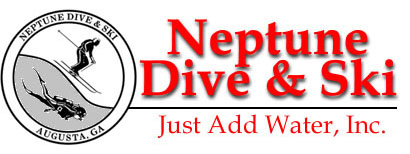SSI Navigation
Course Prerequisites
You must at least have Open Water Diver or Junior Open Water Diver certification. Those taking the course need to be able to add and subtract, and should have some basic knowledge of shapes and geometry.
You must have an active SSI Diver Training Record on file at the dive shop, and a current Medical History form. If you don’t, one can be started for you before you take the class. You must have a current SSI 1) Statement of Understanding, 2) Privacy Statement, 3) Medical History form, 4) Waiver and Release of Liability, and 5) Risk Awareness Verification (video 3). If you do not, please update them before the class session.
Prior to the course, you should have several (around 15) dives under various conditions.
Prospective students must have very good buoyancy control, otherwise the multi-tasking needed for compass navigation will be quite difficult. Students should already be familiar with the East Dam at Lake Thurmond dive site; a Neptune diver will gladly take you for a tour on request.
In addition to the personal and major dive equipment that you used for Open Water Diver checkout, you must have a good-quality compass, an underwater slate, and for each buddy team, a dive float/flag and a good timing device (a watch with a sweep second hand that you can read under water).
The course is online, with review questions. You're expected to complete all sections prior to the class session, which will mostly be workshops on how to use a compass, and how to do the various geometric patterns required at the training dives. There is a written multiple-choice exam.
This is an easy entry-level specialty course - if you take the time to study the academic materials thoroughly, if you take the time to practice land navigation before the open water training dives, if you have a well-prepared buddy, and if you have good buoyancy control. You need to be able to hover at 30, 15, and 10 feet of fresh water in low visibility conditions, and be able to maintain a consistent depth while swimming. Without these skills, the course will be quite difficult.
Divers beginning specialty-level training should have their own equipment and know how to use it. Rental equipment is available, however.
Training is normally done with an absolute maximum of 8 students per instructor. Semi-private (minimum of 2 students) instruction is available on request.
Course Objectives
On completion of this diving specialty course, you should be able to:
- Describe the different geographic formations that can be used for natural navigation
- Understand how different types of illumination can assist your navigation
- Describe bottom contour types and how they can aid in navigation
- Plan and execute a dive using navigation
- Take the compass heading
- Make a note of the heading on a slate
- Realign the north arrow after entry
- Swim with proper body and arm position
- Take time to enjoy the dive site
- Calculate your return setting by adding or subtracting 180 degrees
- Reset your compass for your reciprocal course
- Turn your body to realign the north arrow
- Swim with proper body and arm position
- Describe how and when to combine natural navigation and compass navigation
- Perform the steps necessary to return to a dive site using navigation techniques
- Understand the additional challenges of navigating underwater in limited visibility, at night and in deep water
- Describe new navigation techniques for diving from the beach
- Define how to make navigational adjustments to account for currents
- Describe how to complete multi-course headings
- Understand what dead reckoning is and how to utilize it as a diver
- List different navigational search patterns for the purpose of underwater exploration
- State how to plot a body of water using navigation techniques
Course Outcomes
- On successful completion of the course, you will have reviewed and expanded upon the simple navigation skills introduced in the basic Open Water Diver course.
- You should have greater confidence in navigation for drift diving, anchored boat diving, and low-visibility diving.
- You might even get hooked on the emerging sport of underwater orienteering!
How the Course Works
- The academic portion of the course, including your at-home study of the online Navigation training materials and the class session should take about 6-8 hours. There are no pool sessions, but there is an outdoor land navigation workshop.
- We expect you to study and complete the online course materials very carefully, before the first session.
- You will need to bring a compass and slate, and a reliable timing device (watch) with you for the class session.
- Plan on the class session going from 6pm to 9pm, possibly longer.
- Don't sign up for the class if you don't have the time for study, or if you have to miss a session.
- When you sign up, you’ll be given access to the online training materials at the SSI website, and a book will be ordered for you.
- Please complete all sections of the online course, including the online review questions, prior to the class session. Set aside several hours to do this.
- The class session will only briefly review the academic sections of the course.
- There's a written final exam, which you have to pass with a minimum score of 80%.
- The 2 open water training dives will be at the East Dam area at Clark's Hill Lake (Lake Strom Thurmond). You should already be familiar with this area before taking this course. If not, we can arrange for familiarization dives.
- It is usually possible to complete both open water training dives in one day.


